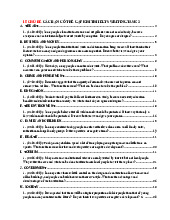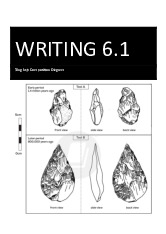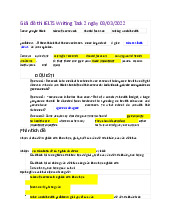











Preview text:
I ELTS Listening – Practice Test 4 Section 1 Questions 1-10 Questions 1-6 Complete the notes below.
Write ONE WORD ONLY for each answer.
THORNDY KE’S BUI LDERS Example
Customer heard about Thorndyke’s from a friend
Name: Edith 1 __________
Address: Flat 4, 2 __________ Park Flats
(Behind the 3 __________) Phone number: 875934
Best time to contact customer: during the 4 __________
Where to park: opposite entrance next to the 5 __________
Needs full quote showing all the jobs and the 6 __________ Questions 7-10 Complete the table below.
Write ONE WORD ONLY for each answer. Area Work to be done Notes Fix tomorrow
Replace the 7 __________ in the door Kitchen
Strip paint and plaster approximately one 9
Paint wall above the 8 __________ __________ in advance
One 10 __________ needs replacing (end of Garden garden) Page 1
I ELTS Listening – Practice Test 4 Section 2 Questions 11-20 Questions 11-15
Choose the correct letter, A, B or C. M ANHAM PORT
11 Why did a port originally develop at Manham?
A It was safe from enemy attack.
В It was convenient for river transport.
C It had a good position on the sea coast.
12 What caused Manham’s sudden expansion during the Industrial Revolution?
A the improvement in mining techniques
В the increase in demand for metals
C the discovery of tin in the area
13 Why did rocks have to be sent away from Manham to be processed? A shortage of fuel В poor transport systems
C lack of skills among local people
14 What happened when the port declined in the twentieth century? A The workers went away.
В Traditional skills were lost.
C Buildings were used for new purposes.
15 What did the Manham Trust hope to do?
A discover the location of the origi nal port
В provide jobs for the unemployed C rebuild the port complex Page 2
I ELTS Listening – Practice Test 4 Questions 16-20
Write NO MORE THAN TWO WORDS for each answer. Complete the table below.
Tourist attractions in M anham Place Features and activities Advice
Specially adapted miners' 16_____
the mine is 17 _____ and enclosed — copper mine
take visitors into the mountain
unsuitable for children and animals
classrooms and a special exhibition of village school
a 19 _____ is recommended 18 _____ "The George" (old
the ship's wheel (was lost but has now
children shouldn't use the 20 _____ sailing ship) been restored) Section 3 Questions 21-30 Questions 21 and 22
Choose TWO letters, A-E.
Which TWO skills did Laura improve as a result of her work placement? A communication В design C IT D marketing E organisation Questions 23 and 24
Choose TWO letters, A-E.
Which TWO immediate benefits did the company get from Laura’s work placement?
A updates for its software В cost savings C an improved image D new clients E a growth in sales Page 3
I ELTS Listening – Practice Test 4 Questions 25-30
What source of information should Tim use at each of the following stages of the work placement? Choose
SI X answers from the box and write the correct letter, A-G, next to questions 25-30. Sources of information A company manager В company’s personnel department C personal tutor D psychology department E mentor
F university careers officer G internet
Stages of the work placement procedure 25 obtaining booklet _____
26 discussing options _____
27 getting updates _____
28 responding to invitation for interview _____
29 informing about outcome of interview _____
30 requesting a reference _____ Section 4 Questions 31-40 Questions 31-33
Choose the correct letter; A, В or C.
Nanotechnology: technology on a small scale
31 The speaker says that one problem with nanotechnology is that
A it could threaten our way of life.
В it could be used to spy on people.
C it is misunderstood by the public.
32 According to the speaker, some scientists believe that nano-particles
A should be restricted to secure environments.
В should be used with more caution.
C should only be developed for essential products.
33 In the speaker's opinion, research into nanotechnology
A has yet to win popular support. В could be seen as unethical. C ought to be continued. Page 4
I ELTS Listening – Practice Test 4 Questions 34-40
Write ONE WORD ONLY for each answer. Complete the notes below. Uses of Nanotechnology Transport
• Nanotechnology could allow the development of stronger 34 _____
• Planes would be much lighter in weight.
• 35 _____ travel will be made available to the masses. Technology
• Computers will be even smaller, faster, and will have a greater 36 _____
• 37 _____ energy will become more affordable. The Environment
• Nano-robots could rebuil d the ozone layer.
• Pollutants such as 38 _____ could be removed from water more easily.
• There will be no 39 _____ from manufacturing. Health and M edicine
• New methods of food production could eradicate famine.
• Analysis of medical 40 _____will be sped up.
• Life expectancy could be increased. Page 5
I ELTS Listening – Practice Test 4 Answer Keys
Section 1 , Questions 1-10
Section 3, Questions 21-30 1 Pargetter
21& 22 in either order: A, E 2 East
23& 24 in either order: В, C 3 library 25 D 4 morning/mornings 26 F 5 postbox 27 G 6 prices 28 В 7 glass 29 E 8 cooker 30 C 9 week 10 fence Section 4, Questions 31-40 31 C
Section 2, Questions 11-20 32 В 11 B 33 C 12 B 34 metal/metals 13 A 35 space 14 A 36 memory 15 C 37 solar 16 trains 38 oil 17 dark 39 waste 18 games 40 tests 19 guided tour 20 ladder/ladders Tapescript
The part of the text containing the answer is underlined with the question number given in square brackets
[]. If you still struggle with IELTS Listening, please refer to Listening tips. I ELTS Listening Section 1
M r. Thorndyke: Thorndyke’s.
M s Pargetter: Good morning. Is that Mr Thorndyke?
M r. Thorndyke: Speaking. How can I help?
M s Pargetter: I’ ve got quite a few things which need painting and fixing in the flat and I wonder whether you'd be able to do the work.
M r. Thorndyke: I’ m sure I’ d be able to help but let me take down a few details.
M s Pargetter: Yes, of course.
M r. Thorndyke: Well, firstly, how did you hear about us?
M s Pargetter: It was my friend May Hamoton... you did some excellent work for her a couple of years ago. Do you remember?
M r. Thorndyke: Oh, yes, that was in West Park Flats, lovely lady.
M s Pargetter: Yes, she is. Page 6
I ELTS Listening – Practice Test 4
M r. Thorndyke: And what’s your name, please?
M s Pargetter: It's Edith Pargetter [1].
M r. Thorndyke: Edith... can you spell your surname, please?
M s Pargetter: It's P-A-R-G-E-double T-E-R [1].
M r. Thorndyke: Double T, right. And do you live in West Park Flats as well?
M s Pargetter: No, actually it’s East Park, Flat 4 [2].
M r. Thorndyke: Oh, right, that’s over the road, I seem to remember - quite difficult to get to.
M s Pargetter: Yes, it’s at the back of the library [3].
M r. Thorndyke: Right, I know. And what’s your phone number?
M s Pargetter: 875934 but I’ m out a great deal in the afternoons and evenings.
M r. Thorndyke: So would the best time to ring you be in the morning? [4]
M s Pargetter: Yes [4].
M r. Thorndyke: Fine. I've made a note of that. Can I just ask, I'll be in a van and I know parking’s rather
difficult round your flats. Where would you recommend?
M s Pargetter: Well, I always tell people in larger vehicles to park by the postbox on the other side of the
road from the entrance [5].
M r. Thorndyke: Good, thanks.
M s Pargetter: And will you be able to give me a full itemised quote?
M r. Thorndyke: Oh. yes. I'll list all the jobs separately with individual prices [6].
M s Pargetter: That'd be a great help.
M r. Thorndyke: No problem. Now, what would you like me to do?
M s Pargetter: Firstly and most urgently is in the kitchen. With all the weather damage, the glass in the
door has cracked and I’ d need that fixing [7].
M r. Thorndyke: I presume you mean replacing?
M s Pargetter: Oh, yes. And as soon as possible...
M r. Thorndyke: What I'll do is come round tomorrow morning and do that immediately.
M s Pargetter: Thank you so much. The other things aren’t so urgent but...
M r. Thorndyke: Now, I'll make a note of everything you want doing.
M s Pargetter: Well, in the kitchen I’ d like some painting doing.
M r. Thorndyke: All the kitchen walls?
M s Pargetter: Just the area over the cooker [8]. It’s very greasy...
M r. Thorndyke: Right... it does tend to get that way! M s Pargetter: Yes!
M r. Thorndyke: Well, if you want a proper job done what I’ d need to do is strip the old paint and plaster it
about a week before I paint it [9].
M s Pargetter: Of course. Now, May tells me you also do work in the garden.
M r. Thorndyke: That’s right.
M s Pargetter: Well, I’ d like you to replace a fence.
M r. Thorndyke: Just one? Page 7
I ELTS Listening – Practice Test 4
M s Pargetter: Yes, at the far end [10].
M r. Thorndyke: Fine. Shouldn’t be a problem.
M s Pargetter: And that’s the lot.
M r. Thorndyke: Fine. Yeah, as I say I can come round tomorrow morning to look over things with you.
M s Pargetter: That’s great, thank you.
M r. Thorndyke: So, I’ ll look forward to seeing you tomorrow at... I ELTS Listening Section 2
Narrator: Welcome to Manham Port, where a thousand years of history are brought to life. All the family
can enjoy a day out at Manham: visit our copper mine, see models of the machinery it used, have your
photo taken in nineteenth-century costume, experience at first hand how people lived at different stages
throughout history, and especially how children studied, worked and played.
The port of Manham is located in beautiful and peaceful countryside, on a bend in the great River Avon, and
developed here because it’s the highest navigable point of the Avon - boats can go no higher up this river -
and proved a handy place to load and unload cargo [11] to and from the sea, which is over 23 miles away.
A small port was already established here when, about 900 years ago, tin was discovered nearby, though it
wasn’t until the Industrial Revolution, when a tremendous need for metals of all kinds developed, that
Manham expanded to become one of the busiest ports in the country [12].
And because it was already so busy, prospectors began to look for other minerals, and by the end of the
nineteenth century, lead, copper, manganese and arsenic were added to the cargos leaving Manham.
In the early days, the ores had been smelted - or processed - in the same area they were mined. But, as
demand grew, the smelting process required huge factory furnaces or fires to melt the metal from the rock
and there was not enough coal in the local area, so the rocks containing minerals had to be shipped long distances [13].
Sadly, in the twentieth century, the great port of Manham declined, and thousands of workers were forced to
emigrate out of the area [14]. The building at the port fell into disrepair, and the place became almost
forgotten. But then, the M anham Trust was formed to conserve the historical resources of the area. It
organised scores of local volunteers to remove undergrowth to find the original outlines of the installations.
It then brought in paid professionals to match installations with maps of the original port complex and to set
about reconstructing it [15].
Today you can see the results of this ambitious programme of restoration. The intention, and we believe this
will be realised before the end of the year, is to return Manham Port to the condition it reached at its peak as
'the greatest copper port in the country’ .
But what can you do and see on your visit today? Here are just a few highlights. We suggest you start with
the visit to the copper mine. Travel on converted mining trains and journey into the depths of the mountain
[16] along seams once worked by hundreds of miners. Page 8
I ELTS Listening – Practice Test 4
Watch out especially for the great pumping machines which rid the mine of water. But please be warned
that, like all mines, ours is very dark and closed in and we do say that children under five and also dogs
should NOT be taken into the mine [17].
The next recommended visit is to the village school. While looking round the classrooms, take a special
look at our display of games [18], which is one of the largest in the world.
And it's recommended that you time your visit to coincide with a guided tour [19]. This will give you the
opportunity to ask lots of questions. Near the school is the beautiful old sailing ketch called ‘ The George'.
You are welcome to board the boat and look round the cabins. Look out for the ship’ s wheel which was
missing until only five years ago when it was dredged out of the silt by a local fisherman. We have no idea
how it got there but it’s been polished and proudly restored to its original place on the boat. Please take care
going down the ladders if you wish to visit the lower deck - we don’ t recommend you allow young children to use them [20].
So we hope you have a memorable visit to Manham Port and will tell your friends all about us I ELTS Listening Section 3
Tim: Hi, Laura - could you spare a few minutes to talk about the work placement you did last summer? I'm
thinking of doing one myself... Laura: Hi, Tim. Sure.
Tim: Didn’t you do yours at an environmental services company?
Laura: That's right... It’s only a very small company and they needed someone to produce a company
brochure, and I wanted to get some business experience because I’ m interested in a career in occupational
psychology in a business environment. It was good because I had overall responsibility for the project.
Tim: What kind of skills do you think you developed on the placement? I mean, apart from the ones you
already had... Did you have to do all the artwork for the brochure, the layout and everything?
Laura: We hired the services of a professional photographer for that. I did have to use my IT skills to a
certain extent because I cut and pasted text from marketing leaf lets, but that didn't involve anything I hadn’t done before.
Tim: Do you think you got any better at managing your time and prioritising things? [21] You always used
to say you had trouble with that...
Laura: Oh. definitely . There was so much pressure to meet the project deadline. And I also got better at
explaining things and asserting my opinions [21, 22], because I had to have weekly consultations with the
marketing manager and give him a progress report.
Tim: It sounds as if you got a lot out of it then.
Laura: Absolutely. It was really worthwhile... But you know, the company benefited too...
Tim: Yes, they must have done. After all, if they’ d used a professional advertising agency to produce their
brochure instead of doing it in-house, presumably they'd have paid a lot more?
Laura: Oh, yes. I worked it out - it would have been 250 per cent more [23].
Tim: And I thought the end resul t was good, even though we did everything on site. The company has quite
a powerful computer and I managed to borrow some scanning software from the university. The new Page 9
I ELTS Listening – Practice Test 4
brochure looks really professional. It enhances the image of the company straight away [24].
Laura: So in the long run it should help them to attract clients, and improve their sales figures?
Tim: That’s the idea. Yeah.
Tim: Well, all in all it sounds very positive - I think I will go ahead and apply for a placement myself. How do I go about it?
Laura: It's easy enough to do, because there’s a government agency called STEP - S-T-E-P - that organises
placements for students. You shoul d start by getting their booklet [25] with all the details - I expect you can
download one from their website.
Tim: Actually, they’ ve got copies in the psychology department [25] - I’ ve seen them there. I'll just go to the office and pick one up.
Laura: Right. And then if I were you, after I’ d looked at it I'd go over all the options with someone...
Tim: I suppose I should ask my tutor’s advice. He knows more about me than anyone.
Laura: One of the career officers would be better [26], they’ ve got more knowledge about the jobs market
than your personal tutor would have. Tim: OK...
Laura:And then when you know what you want you can register with STEP - you’ ll find their address in
the booklet. And once you’ ve registered they assign you to a mentor who looks after your application.
Tim:And then I suppose you just sit back and wait till you hear something? They told me at the careers
office that it’s best to be proactive, and get updates yourself by checking the website for new placement alerts [27].
Laura: Your mentor is supposed to keep you informed, but you can't rely on that.
Tim:I don’ t suppose it’s a good idea to get in touch with companies directly, is it?
Laura: Not really... But it is the company who notifies you if they want you to go for an interview. You get
a letter of invitation or an email from personnel departments [28].
Tim:And do I reply directly to them?
Laura: Yes, you do STEP only gets involved again once you've been made a job offer.
Tim: Right... So, once you’ ve had an interview you should let your mentor know what the outcome is? I
mean whether you’ re offered a job, and whether you’ ve decided to accept it?
Laura: That’s right [29]. They'll inform the careers office once a placement has been agreed, so you don’t have to do that. Tim:Is that all then?
Laura: More or less. Only once you’ ve accepted an offer you’ ll probably have to supply a reference [30],
because the placement will be conditional on that.
Tim:And that’s something you should ask your own tutor to provide [30].
Laura: He knows about your academic ability and also about your qualities, like reliability.
I ELTS Listening Section 4
Narrator: Today we’ re going to look at an important area of science, namely nanotechnology. So what is
it? Nano means tiny, so it’s science and engineering on the scale of atoms and molecules. The idea is that by Page 10
I ELTS Listening – Practice Test 4
controlling and rearranging atoms, you can literally create anything. However, as we’ ll see, the science of
the small has some big implications affecting us in many ways.
There’s no doubt that nanotechnology promises so much for civilisation. However, all new technologies
have their teething problems. And with nanotechnology, society often gets the wrong idea about its capabilities [31].
Numerous science-fiction books and movies have raised people's fears about nanotechnology - with
scenarios such as inserting little nano-robots into your body that monitor everything you do without you
realising it, or self-replicating nano-robots that eventually take over the world.
So how do we safeguard such a potentially powerful technology? Some scientists recommend that nano-
particles be treated as new chemicals with separate safety tests and clear labelling [32].
They believe that greater care should also be taken with nano-particles in laboratories and factories [32].
Others have called for a withdrawal of new nano products such as cosmetics and a temporary halt to many
kinds of nano-tech research. But as far as I’ m concerned there's a need to plough ahead with the discoveries
and applications of nanotechnology [33].
I really believe that most scientists would welcome a way to guard against unethical uses of such
technology. We can’t go around thinking that all innovation is bad, all advancement is bad. As with the
debate about any new technology, it is how you use it that’s important. So let’s look at some of its possible uses.
Thanks to nanotechnology, there could be a major breakthrough in the field of transportation with the
production of more durable metals [34]. These could be virtually unbreakable, lighter and much more
pliable leading to planes that are 50 times lighter than at present. Those same improved capabilities wil l
dramatically reduce the cost of travelling into space making it more accessible to ordinary people [35] and
opening up a totally new holiday destination.
In terms of technology, the computer industry will be able to shrink computer parts down to minute sizes.
We need nanotechnology in order to create a new generation of computers that will work even faster and
will have a million times more memory [36] but will be about the size of a sugar cube.
Nanotechnology could also revolutionise the way that we generate power. The cost of solar cells will be
drastically reduced so harnessing this energy will be far more economical [37] than at present.
But nanotechnology has much wider applications than this and could have an enormous impact on our
environment. For instance, tiny airborne nano-robots could be programmed to actually rebuild the ozone
layer, which could lessen the impact of global warming on our planet. That’s a pretty amazing thought, isn’ t
it? On a more local scale, this new technology could help with the clean-up of environmental disasters as
nanotechnology will allow us to remove oil and other contaminants from the water far more effectively
[38]. And, if nanotechnology progresses as expected - as a sort of building block set of about 90 atoms -
then you could build anything you wanted from the bottom up. In terms of production, this means that you
only use what you need and so there wouldn't be any waste [39]. Page 11
I ELTS Listening – Practice Test 4
The notion that you could create anything at all has major implications for our health. It means that we’ ll
eventually be able to replicate anything. This would have a phenomenal effect on our society. In time it
could even lead to the eradication of famine through the introduction of machines that produce food to feed the hungry.
But it’s in the area of medicine that nanotechnology may have its biggest impact. How we detect disease
will change as tiny biosensors are developed to analyse tests in minutes rather than days [40]. There’s even
speculation nano-robots could be used to slow the ageing process, lengthening life expectancy.
As you can see, I’ m very excited by the implications that could be available to us in the next few decades.
Just how long it’ ll take, I honestly don't know. Page 12




